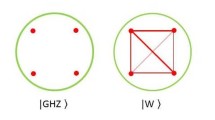Abstract
For n ≥ 3, we construct a class \(\left\{{{W_{n,{\pi _1},{\pi _2}}}} \right\}\) of n2 × n2 hermitian matrices by the permutation pairs and show that, for a pair {π1, π2} of permutations on (1, 2, …, n), \({{W_{n,{\pi _1},{\pi _2}}}}\) is an entanglement witness of the n ⊗ n system if {π1, π2} has the property (C). Recall that a pair {π1, π2} of permutations of (1, 2, …, n) has the property (C) if, for each i, one can obtain a permutation of (1, …, i − 1, i + 1, …, n) from (π1 (1), …, π1 (i − 1), π1(i + 1), …, π1(n)) and (π2(1), …, π2(i − 1), π2(i + 1), …, π2(n)). We further prove that \({{W_{n,{\pi _1},{\pi _2}}}}\) is not comparable with Wn,π, which is the entanglement witness constructed from a single permutation π; \({{W_{n,{\pi _1},{\pi _2}}}}\) is decomposable if π1π2 = id or π 21 = π 22 = id. For the low dimensional cases n ∈ {3, 4}, we give a sufficient and necessary condition on π1, π2 for \({{W_{n,{\pi _1},{\pi _2}}}}\) to be an entanglement witness. We also show that, for n ∈ {3, 4}, \({{W_{n,{\pi _1},{\pi _2}}}}\) is decomposable if and only if π1π2 = id or π 21 = π 22 ; = id; \({{W_{3,{\pi _1},{\pi _2}}}}\) is optimal if and only if (π1, π2) = (π, π2), where π = (2, 3,1). As applications, some entanglement criteria for states and some decomposability criteria for positive maps are established.
Similar content being viewed by others
References
Arveson W. Maximal vectors in Hilbert spaces and quantum entanglement. J Funct Anal, 2009, 256: 1476–1510
Augusiak R, Tura J, Lewenstein M. A note on the optimality of decomposable entanglement witnesses and completely entangled subspaces. J Phys A: Math Theor, 2011, 44: 212001
Guo Y, Hou J C. Realignment operation and CCNR criterion of separability for states in infinite-dimensional quantum systems. Reports on Mathematical Physics, 2013, 72: 25–40
Guo Y, Qi X F, Hou J C. Sufficient and necessary conditions of separability for bipartite pure states in infinite-dimensional systems. Chinese Science Bull, 2011, 56: 840–846
Horodecki M, Horodecki P, Horodecki R. Separability of mixed states: necessary and sufficient conditions. Phys Lett A, 1996, 233: 1
Horodecki P. Separability criterion and inseparable mixed states with positive partial transposition. Phys Lett A, 1997, 232: 333–339
Hou J C, A characterization of positive linear maps and criteria for entangled quantum states. J Phys A: Math Theor, 2010, 43: 385201
Hou J C, Guo Y. When different entanglement witesses detect the same entangled states. Phy Rev A, 2010, 82: 052301
Hou J C, Guo Y. Constructing entanglement witnesses for states in infinite-dimensional bipartite quantum systems. Int J Theor Phy, 2011, 50: 1245–1254
Hou J C, Li C K, Poon X T, et al. A new criterion and a special class of k-positive maps. Lin Alg Appl, 2015, 470: 51–69
Hou J C, Qi X F. Constructing entanglement witnesses for infinite-dimensional systems. Phy Rev A, 2010, 81: 062351
Hou J C, Wang W L. Constructing entanglement witnesses for infinite-dimensional systems. Int J Theor Phy, 2019, 58: 1269–1281
Hou J C, Zhao H L. Positive maps constructed from permutation pairs. Acta Mathematica Scientia, 2019, 39B: 1–17
Lewensetein M, Kraus B, Cirac J I, Horodecki P. Optimization of entanglement witness. Phys Rev A, 2001, 62: 052310
Nielsen M A, Chuang I L. Quantum Computatation and Quantum Information. Cambridge: Cambridge University Press, 2000
Peres A. Separability criterion for density matrices. Phy Rev Lett, 1996, 77: 1413
Qi X F, Hou J C. Detecting entanglement of states by entries of their density matrices. Int J Theor Phy, 2012, 51: 2003–2014
Qi X F, Hou J C. Characterization of optimal entanglement witnesses. Phy Rev A, 2012, 85: 022334
Qi X F, Hou J C. Optimality of a class of entanglement witnesses for 3 ⊗ 3 systems. Int J Theor Phy, 2013, 52: 3474–3
Qi X F, Hou J C. Optimality of entanglement witnesses constructed from arbitrary permutations. Quantum Information Processing, 2015, 14: 2499–2515
Qi X F, Hou J C. Indecomposability of entanglement witnesses constructed from any permutations. Quantum Information and Computation, 2015, 15: 0478–0488
Qi X F, Hou J C. Positive finite rank elementary operators and characterizing entanglement of states. J Phy A: Math Theor, 2011, 44: 215305
Rudolph O. Further results on the cross norm criterion for separability. Quantum Information Processing, 2005, 4: 219
Størmer E. Separable states and positive maps. J Funct Anal, 2008, 254: 2303–2312
Tóth G, Gühne O. Separability criteria and entanglement witnesses for symmetric quantum states. Appl Phy B, 2010, 98: 617–622
Wu Y C, Han Y J, Guo G C. When different entanglement witnesses can detect the same entangled states. Phy Lett A, 2006, 356: 402–405
Yu S, Liu N L. Entanglement detection by local orthogonal observables. Phy Rev Lett, 2005, 95: 150504
Zhao H L, Hou J C. A necessary and sufficient condition for positivity of linear maps on M4 constructed from permutation pairs. Operator and Matrices, 2015, 9(3): 597–617
Author information
Authors and Affiliations
Corresponding author
Additional information
This work is partially supported by National Natural Science Foundation of China (11671294, 12071336).
Rights and permissions
About this article
Cite this article
Hou, J., Wang, W. Entanglement Witnesses Constructed By Permutation Pairs. Acta Math Sci 41, 843–874 (2021). https://doi.org/10.1007/s10473-021-0313-z
Received:
Revised:
Published:
Issue Date:
DOI: https://doi.org/10.1007/s10473-021-0313-z



